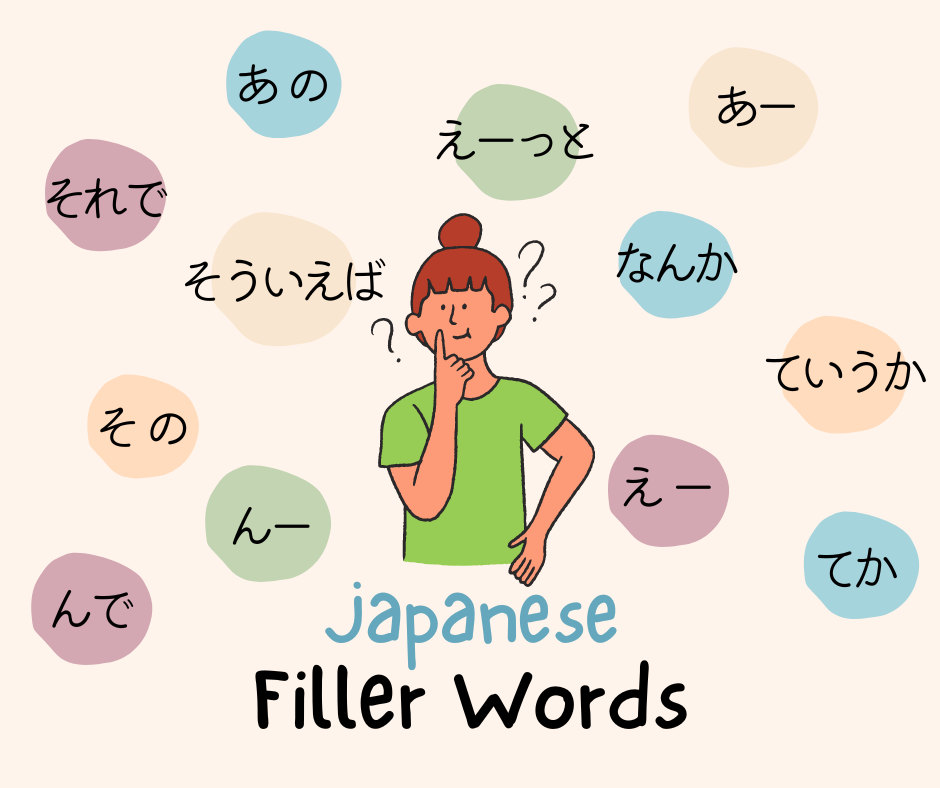We all use filler words every day in English, right? Filler words are used so often and so naturally that we don’t even notice when we say or hear them. Nonetheless, they are essential to a language. Here are 10 Japanese filler words you can use to squash any awkwardness!
Filler words are a helpful tool that is extremely useful when it comes to speaking naturally and smoothly. This is also the case in the Japanese language! So, in order to start sounding more like a native speaker, one must learn how to use filler words.
What is a filler Word?
Filler words in English are words such as “um,” “well,” “uh,” and “like.” We use these words so that we can fill those “gaps” in a conversation. What are those “gaps”? They usually occur when we are not sure about what to say, and need some time to think… but we also want to convey to others that we are still talking. They can also be used to indicate that you’re unsure about something.
Check out the Youtube Video I made on this topic!
So now that we’ve got that covered, let’s get into 10 useful Japanese filler words that Japanese speakers use every day!
1. あのー (um)
- すみません。あのー東京駅はどこですか?
sumimasen. anoーtoukyou eki wa doko desu ka?
“Excuse me. Um… where is Tokyo Station?”
This is one of the most commonly used filler words in Japanese. In the example, and in many cases, 「あのー」 can be used as a way to ask a question, especially to a stranger. It can also just be used any time you need some time to think before speaking. This filler word can be used in formal situations as well.
2. そのー (um)
- そのー…それは良くないと思いますが…。
sonoー… sore wa yokunai to omou kedo…
“Ummm… I think that’s not good though…” (in natural English, it’s more like “Ummm… I don’t think that’s a good idea though…”)
「そのー」can also be used as a normal filler word in Japanese like the English “um,” but it can specifically be used for situations in which you want to say something that might offend someone, or might be a touchy subject, but also want to deliver it softly. This filler word is typically more formal in its use.
3. えー
- 東京駅は、えー… あっちじゃない?
toukyou eki wa, eー… acchi jyanai?
Isn’t Tokyo station, uhhh… that way?
This filler word is probably the most commonly used filler word in Japanese. It’s just like the sound “uh” in English. It can be used any time in your Japanese speaking and is essentially a filler sound. It can be used to fill any empty space in your conversation.
4. えーっと / ええと
- すみません。えーっと…メロンのアレルギーがあります。
sumimasen, ēto… meron no arerugī ga arimasu.
Sorry, erm, I am allergic to melon.
「えーっと」 / 「ええーと」 can be used the same way as 「あの」, but there is a bit of difference in the nuance between the two. It’s also used as a way to deliver something softly so as not to sound so blunt. For example, you might want to say the sentence above if someone has served you melon without knowing about your allergy. 「えーっと」 / 「ええと」 has a feeling of inferiority, maybe akin to the English “erm”.

5. うーん
- うーん…今日は何をしようかな…?
uーn… kyou wa nani wo shiyou kana…?
hmmm… I wonder what we shall do today…?
This filler word is used when you’re thinking about something. It’s something akin to the English “hmmm…” 「うーん」 indicated to the person you’re talking to that you’re contemplating something. It’s a bit more of a sound rather than a word.
6. そういえば / そういや
- そういえば、田中くんって結婚したらしいよ。
souieba, tanaka-kun tte kekkon shita rashii yo.
Come to think of it, I heard that Tanaka Kun got married.
「そういえば」in English means “come to think of it”. It’s an interjectory word that is used when you remembered something that you want to talk about. It’s also used when what was said by someone (maybe yourself) made you remember something a bit off-topic. 「そういえば」can be handy even if you just want to change the subject. 「そういえば」is the formal version, where as「そういえや」should only be used in casual settings.
7. なんか
- なんかこの辺臭くない?
nanka kono hen kasakunai?
like, doesn’t this area stink?
This filler word is definitely a favorite among young Japanese speakers. The perfect comparison would be to the English word “like”. Much like “like”, 「なんか」can be placed anywhere in a sentence. It gives off the feeling that you aren’t too confident in what you are saying. You might have guessed already that this filler word is casual and therefore should be avoided when formally speaking.

8. ていうか / てか
- 今日暑いよねー。てか、暑すぎじゃない?
kyou atsui yo neー. teka, atsusugi jyanai?
It’s so hot today, huh? I mean, isn’t it too hot?
「ていうか」/「てか」are also mostly said by young people. In English, it means “I mean”. 「ていうか」and「てか」are both very casual, although 「てか」is even more casual than 「ていうか」. This filler word is usually used in the middle of speaking, just like how you would use “I mean…”.
9. あー
- あー…彼女の名前は何だっけ?
aー… kanojyo no namae wa nan da kke?
uhh… what was her name again?
This filler word isn’t so much of a word as much as it is just a sound. It can be used any time and in any situation, just like the filler word 「えー」.
10. それで / んで / で
- 最近運動始めました。それで、健康になりました。
saikin undou hajimemashita. sorede, kenkou ni narimashita.
I began exercising recently. And then, I became healthy.
「それで」is the most formal of the three, whereas「んで」is casual and「で」is even more casual. It means something like “and then…” This filler word is useful when you want to keep talking and add more to your story, while adding just a little bit of suspense along the way.
Don’t use filler words too much.
Have you ever been listening to someone, and you start to notice how often they are saying a certain filler word like “ummm” or “like”? Once you notice this, you start focusing less on what they’re actually saying and more on the filler words. This is why they should always be used in moderation.
It’s important to be careful about when you should use filler words and what filler words are okay to use in certain situations. Anything really goes when it’s a casual setting such as talking to your friends. However, in a formal or business setting, one should refrain from using too many filler words and maybe only use the reliable 「えー」 every now and then.
We hope you have been able to learn new filler words that can upgrade your Japanese abilities! Thank you for reading!
Vocabulary Used
- すみません / sumimasen — excuse me
- 東京 / とう・きょう / Toukyou — Tokyo
- 駅 / えき / eki — station
- どこ / doko — where
- それ / sore / — that, it
- 良くない / よくない / yokunai — not good (comes from 良い)
- 思う / おもう / omou — to think
- -が / -ga — though, but
- あっち / acchi — that way, there
- メロン / meron — melon
- アレルギー / arerugī — allergy
- 今日 / kyou — today
- 何 / nani — what
- -しよう / -shiyou — let’s do (comes from する)
- 結婚する / kekkon suru — to get married
- -らしい / -rashii — (used at the end of a sentence) “or so I heard”, “it was said that…”
- この辺 / (casually read as konohen) (formally read as konoatari) — this area
- 臭い / kusai — stinky, smelly
- 暑い / atsui — hot
- 彼女 / kanojyo — she, her
- 名前 / namae — name
- 最近 / saikin — recently
- 運動 / undou — exercise
- 始める / hajimeru — to begin
- 健康 / kenkou — health
- なる / naru — to become
All of the vocabulary used in this post are beginner Japanese words. I recommend you to study any words that you see here!

